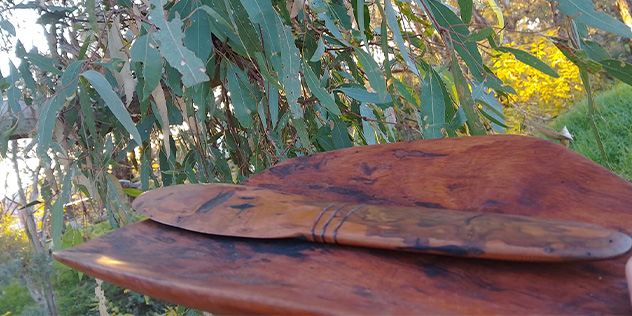
— Haylie Beckett, Indigenous Engagement Advisor, recalling the NRMA Reconciliation Day event in Canberra.
The message stick’s journey ties into the ongoing work of reconciliation, serving as a living symbol of the NRMA’s dedication to learning from, and partnering with, First Nations communities. It’s also a reminder that reconciliation isn’t a static goal but an ongoing process. One that requires listening, learning, and taking meaningful action year-round, not just during NAIDOC Week.
*From NAIDOC.org.au: The National NAIDOC Committee respectfully acknowledges the now defunct and inaccurate term 'Aborigines', whilst retaining the term in our title due to historic use by our Elders in establishing this week of commemoration in 1938. As at 1967 the ongoing registered title of the Committee became the National Aboriginal and Islander Day Observance Committee.
Each year in July, Australia comes together to celebrate NAIDOC Week as a time to recognise and honour the history, culture and achievements of Aboriginal and Torres Strait Islander peoples.
NAIDOC Week is much more than a cultural event. It’s an opportunity for First Nations Peoples to celebrate the art, musical, people, and stories that make up the world’s oldest continuous cultures. And a time for all Australians to show support for the rights and aspirations of First Nations communities.
This year, the NRMA has embraced the spirit of NAIDOC Week in a truly meaningful way: through the journey of a specially crafted message stick.
Crafted for the NRMA by a local Yuin man from wood local to Murramarang, this message stick has travelled thousands of kilometres across Australia, visiting NRMA corporate offices, NRMA Parks and Resorts, SIXT car rental branches and more, carrying with it a story of connection, respect and reconciliation.
NAIDOC stands for the National Aboriginies and Islanders Day Observance Committee*. Its origins date back to the 1938 Day of Mourning, one of the first major civil rights gatherings in the country.
Today, NAIDOC Week is held every July to celebrate Aboriginal and Torres Strait Islander history, culture and achievements. Each year features a different theme—this year’s theme, “The Next Generation: Strength, Vision & Legacy”, celebrates not only the achievements of the past but the bright future ahead, empowered by the strength of young leaders.
Across Australia, communities come together for events such as cultural performances, art exhibitions, discussions on Indigenous issues, and more.
For businesses and organisations like the NRMA, it’s also a time to reflect on how we can continue to support reconciliation and foster meaningful relationships with First Nations peoples.

The NRMA's message stick has travelled the nation.
Central to NRMA’s NAIDOC Week celebrations this year has been the journey of a message stick - an artefact deeply rooted in Aboriginal culture.
Traditionally, message sticks were carved pieces of wood and used by Aboriginal people to communicate between different nations across Australia. Each stick was unique, with markings and symbols that conveyed specific messages, serving as both a physical and cultural link between communities.
Message sticks were often carried by messengers travelling long distances, who would use them to gain safe passage through other groups’ territories or to invite neighbouring mobs to gatherings such as corroborees or ceremonies. In this way, message sticks represent not just communication, but trust, respect, and connection across diverse Country.
The NRMA’s message stick started its journey in 2024 at the launch of NRMA’s Stretch RAP.
Since its creation, this message stick has travelled extensively, visiting NRMA’s corporate offices in Sydney and beyond, as well as many of its 45+ holiday parks and resorts across Australia. Additionally, the message stick was present at NRMA sponsored events like the Koori Knockout and Elders Olympics.
It has also been welcomed at SIXT car rental branches spanning urban centres and regional towns. Each stop has been an opportunity for teams to gather, learn about the cultural significance of the message stick, and imbue the stick with their own messages Australia’s reconciliation journey.
A First Nations Elder who is a resident of an NRMA Holiday Park even added her own symbol to the message stick.